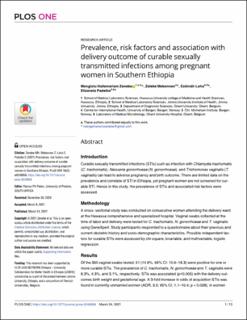| dc.contributor.author | Zenebe, Mengistu Hailemariam | |
| dc.contributor.author | Mekonnen, Zeleke | |
| dc.contributor.author | Loha, Eskindir | |
| dc.contributor.author | Padalko, Elizaveta | |
| dc.date.accessioned | 2022-01-21T14:02:25Z | |
| dc.date.available | 2022-01-21T14:02:25Z | |
| dc.date.created | 2021-07-19T20:49:19Z | |
| dc.date.issued | 2021 | |
| dc.identifier.issn | 1932-6203 | |
| dc.identifier.uri | https://hdl.handle.net/11250/2838755 | |
| dc.description.abstract | Introduction
Curable sexually transmitted infections (STIs) such as infection with Chlamydia trachomatis (C. trachomatis), Neisseria gonorrhoeae (N. gonorrhoeae), and Trichomonas vaginalis (T. vaginalis) can lead to adverse pregnancy and birth outcome. There are limited data on the prevalence and correlate of STI in Ethiopia, yet pregnant women are not screened for curable STI. Hence in this study, the prevalence of STIs and associated risk factors were assessed.
Methodology
A cross- sectional study was conducted on consecutive women attending the delivery ward at the Hawassa comprehensive and specialized hospital. Vaginal swabs collected at the time of labor and delivery were tested for C. trachomatis, N. gonorrhoeae and T. vaginalis using GeneXpert. Study participants responded to a questionnaire about their previous and current obstetric history and socio-demographic characteristics. Possible independent factors for curable STIs were assessed by chi-square, bivariable, and multivariable, logistic regression.
Results
Of the 350 vaginal swabs tested, 51 (14.6%, 95% CI: 10.9–18.3) were positive for one or more curable STIs. The prevalence of C. trachomatis, N. gonorrhoeae and T. vaginalis were 8.3%, 4.3%, and 3.1%, respectively. STIs was associated (p<0.005) with the delivery outcomes birth weight and gestational age. A 3-fold increase in odds of acquisition STIs was found in currently unmarried women (AOR, 3.5; 95% CI: 1.1–10.4; p = 0.028), in women <25 years (AOR, 2.7; 95% CI 1.1–6.6; p = 0.031). Women reporting presence of vaginal discharge (AOR, 7.7; 95% CI: 3.2–18.6; p < 0.001) and reporting pain during urination (AOR, 6.5; 95% CI: 2.6–16.2; p <0.001) found to associate with curable STIs.
Conclusion
The higher magnitude of STIs found in this population, and the absence of symptoms in many illustrate the need for systematic follow-up during routine antenatal care primarily history taking and asking for signs and symptoms to provide early management and avoid long term sequelae. | en_US |
| dc.language.iso | eng | en_US |
| dc.publisher | Public Library of Science | en_US |
| dc.rights | Navngivelse 4.0 Internasjonal | * |
| dc.rights.uri | http://creativecommons.org/licenses/by/4.0/deed.no | * |
| dc.title | Prevalence, risk factors and association with delivery outcome of curable sexually transmitted infections among pregnant women in Southern Ethiopia | en_US |
| dc.type | Journal article | en_US |
| dc.type | Peer reviewed | en_US |
| dc.description.version | publishedVersion | en_US |
| dc.rights.holder | Copyright 2021 Zenebe et al. | en_US |
| dc.source.articlenumber | e0248958 | en_US |
| cristin.ispublished | true | |
| cristin.fulltext | original | |
| cristin.qualitycode | 1 | |
| dc.identifier.doi | 10.1371/journal.pone.0248958 | |
| dc.identifier.cristin | 1922138 | |
| dc.source.journal | PLOS ONE | en_US |
| dc.identifier.citation | PLOS ONE. 2021, 16 (3), e0248958. | en_US |
| dc.source.volume | 16 | en_US |
| dc.source.issue | 3 | en_US |

